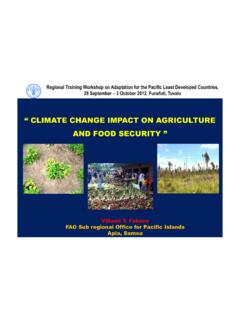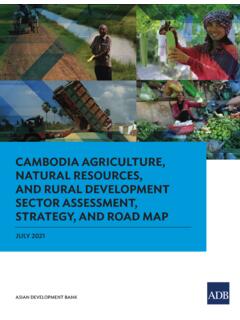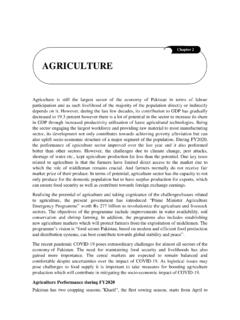Transcription of Agriculture and Agronomy - Hasanuzzaman's Homepage
1 1 Agriculture and Agronomy 2020 Mirza Hasanuzzaman Also available at: This hand-out is not an alternative of Class Lectures or Books:: FOR STUDENTS' USE ONLY INTRODUCTION TO Agriculture AND Agronomy Concept of Agriculture The word Agriculture has been derived from two Latin words ager means land or field and cultura means cultivation. So, literally Agriculture means the production of crops for economic purpose by cultivating soil. Agriculture may also be defined as the biological exploitation of soil for the purpose of production. But in broad sense, Agriculture is the branch of applied science, which deals with production, improvement, protection, processing, marketing, extension etc. of crops by proper utilization of natural resources. The natural resources are soil, sunlight, air, water, temperature etc. A crop is an organism grown or harvested for obtaining yield, which has economic value.
2 , rice, fish, cattle, poultry, etc. So, Agriculture deals not only with the economic plants but also with the animals, which have economic value. Branches of Agriculture There are different branches of Agriculture . The major branches of Agriculture are as follows: Evolution of Agriculture Excavations, legends and remote sensing tests reveal that Agriculture is 10,000 years old. Women by their intrinsic insight first observed that plants come up from seeds. Men concentrated on hunting and gathering (Paleolithic and Neolithic periods) during that time. Women were the pioneers for cultivating useful plants from the wild flora. Deals with economic plants. , rice, jute, potato etc. Crop science Deals with animal production, , cattle, buffalo, goat, poultry etc. Animal husbandry Deals with the diseases and treatments of animal. Veterinary Deals with pisciculture (rearing and managing fishes). Fisheries Deals with farm mechanization.
3 Agricultural engineering Deals with economic management and marketing of agricultural products. Agricultural economics Deals with integrated crop and forest plants production. Agro-forestry Mirza Hasanuzzaman, PhD Professor Department of Agronomy Sher-e-Bangla Agricultural University E-mail: 2 Agriculture and Agronomy 2020 Mirza Hasanuzzaman Also available at: This hand-out is not an alternative of Class Lectures or Books:: FOR STUDENTS' USE ONLY Evolution of Agriculture involves the gradual changes of Agriculture from the ancient era to the civilized condition. It involves the following gradual stages: 1. Primary/ primitive/ root grabbing stage: At that stage, human being came on the earth. People were helpless and nomad and they had no houses. They were always afraid of wild animals. They used to take shelter together in the cave, earth-hole and branch of trees to escape themselves from the wild animals.
4 They had no idea about food and crop production and used to live on natural fruits and roots. 2. Hunting and old stone stage: Before that stage, people used to face wild animals during collection of natural fruits and roots. At that stage, people had learned to save themselves from the wild animals by throwing large sized stones to those animals. They learned to make arms by breaking large sized stones for hunting. They used to eat flesh of wild animals. Gradually, women used to collect fruits and roots from near households. Thus they started to eat fruits and roots by flesh of wild animals. Women started to wear animal skin. 3. Fire and new stone stage: At that stage, people were able to make fire and prepare improved arms. They got the idea of making fire when they used to break the large sized stones into small pieces. They were able to make sharp and pointed arms by rubbing one stone with another.
5 People learned to burn the flesh of wild animals and thus started to eat burnt flesh. Thus gradually the insecure condition of the people was changed. 4. Animal domestication/ husbandry stage: At that stage, men became expert in hunting wild animals. They used to hunt more than one animal and ate them as per requirement. Excess and gentle animals were kept for future use. Thus, animal domestication was started. Less stronger animals like cattle, goat, sheep, dog, ass etc. were domesticated first. Women and children used to take care and manage feed for those animals. Thus, animal husbandry was started first. They used to eat natural fruits and roots and did not know how to produce them. So, people used to move from one location to another for their own food and animal feed. 5. Crop production stage: After thousands of years, people wanted to settle down in a permanent site, as nomad life was unbearable.
6 People observed that plants come up from maize seeds kept on the graveyard. Probably women by her intrinsic insight nurtured the sprouts to harvest near households. Thus, women are the pioneers of Agriculture . Then people started to use fire and digging land by sticks to prepare garden plots in which they would grow small grains. They started cultivation by pointed sticks and branches of trees. Modern Agriculture was started from 18th century. Green revolution was started in 1960s. 1. Primary/ Primative stage 2. Hunting/ Old stone stage 3. Fire/ New stone stage 4. Animal domestification stage 5. Crop production stage Modern Agriculture 3 Agriculture and Agronomy 2020 Mirza Hasanuzzaman Also available at: This hand-out is not an alternative of Class Lectures or Books:: FOR STUDENTS' USE ONLY Importance of Agriculture Agriculture is directly or indirectly contributing in many sectors of our basic needs or livelihoods which are described under following heads: 1.
7 Food Food is required for normal growth and energy of the body. Agriculture is the source of the following food elements- Carbohydrate cereals (70-75%), potato & sweet potato (18-20%) Protein meat and fish (18-20%), egg (12-13%), milk ( ), Pulses (27-28%). Fat mustard and rapeseed (40-45%), soybean (20-25%), groundnut (44-46%), sunflower (42-44%), sesame (41-43%). Vitamins & minerals various fruits, vegetables, milk, butter etc. 2. Clothes Agriculture provides us fiber to make clothes. In the world, 70% of the fiber comes from cotton (Gossypium spp.). Other sources are jute, wool, silk, natural fiber etc., which are also obtained from Agriculture . 6. Houses People gradually felt the necessity of making houses to escape themselves from wild animals, rain, sunshine, cyclone etc. Maximum housing materials are the products of Agriculture . Such as, timber, bamboo, straw, rope etc. 4. Industry Agriculture provides raw materials in different industries.
8 Some of the industries in which Agriculture supplies raw materials are mentioned below: a. Medicine industry: Maximum medicine industries utilize different medicinal plants like arjun, sesame etc., which are the contributions of Agriculture . b. Paper industry: Bamboo, geoa, straw etc., are used in paper industries. c. Rubber industry: Rubber is prepared from the latex of rubber plant. It is used to prepare tier, tube and room of different vehicles and also used in different industrial products. d. Soap, candle and paint industry: Different oils (mustard, sesame, linseed, groundnut) animal fats (goat, cattle), wax of honeybee chamber, turmeric, safflower etc. are used in this industry. e. Perfume industry: Volatile oils extracted from different plant parts are used to prepare perfume. This perfume is used directly or to prepare perfumery, medicine and food materials. f. Beverage industry: Tea, coffee, Coca-Cola, etc.
9 Are prepared from agricultural raw materials. g. Bakery: Flour, egg, sugar, oil etc. agricultural products are used in preparing different bakery products like biscuits, cake etc. h. Sugar industry: Sugarcane, sugarbeet, date palm etc. are used to prepare sugar in the sugar industry. i. Narcotic and chewing industry: Different agricultural products are used in narcotic and chewing industry. , tobacco, cocoa etc. j. Leather industry: Hide and skin of different animals used in leather industry. 4 Agriculture and Agronomy 2020 Mirza Hasanuzzaman Also available at: This hand-out is not an alternative of Class Lectures or Books:: FOR STUDENTS' USE ONLY 5. Fuel Fuel of brick fields (timber, jute-stick, dry leaves etc.). Coal, petrol and gasses are obtained from plant materials. Biodiesel is one of the new ideas where diesel can be obtained from plant named Jatropha.
10 6. Earning source People take Agriculture directly or processing of agricultural products as an occupation and thus earn money. Agricultural products may be marketed in the local market or may be exported. Around 62% of the rural people are directly engaged in Agriculture where most of the people are related to crop enterprises. Agriculture still employs about of total employment of the country (BBS 2018). 7. Foreign currency Some agricultural products directly or in processed condition are exported and thus earned foreign currency. Such as, rice, jute, wheat, tomato, frozen fish, vegetables etc. 8. International relation By exporting and importing of agricultural commodities a country can establish a good relation with the foreign countries. For example, Bangladesh exports tea, shrimp, jute & jute products and importing apple, grape etc. and import oils, pulses and grains as well as many fruits from abroad.






